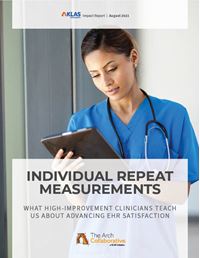Individual Repeat Measurements
What High-Improvement Clinicians Teach Us about Advancing EHR Satisfaction
To date, over 45 Arch Collaborative organizations have used the EHR Experience Survey to measure their clinicians’ EHR satisfaction at least twice, capturing the repeat scores of over 30,000 clinicians. Between measurements, these organizations have implemented changes to training, technology, governance, and other areas in hopes of improving their end users’ EHR satisfaction. While previous Arch Collaborative reports (click here for the latest) have explored the impact of these changes at the organizational level, this report examines how the satisfaction of individual clinicians has improved or declined from measurement to measurement and what we can learn from clinicians who have seen the biggest increases.
Want to see full details?
Want to see full details?
Here is my information:
33% of Repeat Individuals Report Significant Improvement
Changes in Net EHR Experience Score (NEES)† between a clinician’s first and second measurement have an almost perfect normal distribution, validating the accuracy of the survey in gauging EHR satisfaction. While the average clinician reports a 6.3-point improvement, approximately 33% of clinicians have seen highly significant improvement (i.e., an increase in NEES of at least 20 points). Analyzing the data from these “high-improvement” clinicians reveals the factors most commonly associated with improved EHR satisfaction (see below).

† Each individual clinician’s responses to the Arch Collaborative EHR Experience Survey regarding core factors such as the EHR’s efficiency, functionality, impact on care, and so on are aggregated into an overall Net EHR Experience Score (NEES), which represents a snapshot of the clinician’s overall satisfaction with the EHR environment at their organization. The NEES is calculated by subtracting the percent of negative user feedback from the percent of positive user feedback. An NEES can range from -100 (all negative feedback) to 100 (all positive feedback).
The Individual Metrics Most Commonly Associated to High Overall Improvement

Almost all clinicians in the high-improvement group report an increase in their personal accountability for mastering the EHR. This validates a key finding of the Collaborative, which is that—across metrics—users themselves can account for up to 40%–60% of the variation in their EHR satisfaction (see “Stakeholder” chart below). See the Intermountain Healthcare case study to learn how that organization’s focus on provider coaching led to improved perceptions of the EHR.
Other common associated improvements include improved perceptions of the EHR vendor, increased satisfaction with the quality and frequency of ongoing training, and greater adoption of personalization. This validates the importance of two of the Arch Collaborative’s three pillars of EHR satisfaction: training (both initial and ongoing) is an important aspect of the user mastery pillar, while personalization is critical to the EHR “meeting unique user needs.” See full report for additional details on the three pillars.


The Individual Metrics with Most Impactful Association to High Overall Improvement
While personal accountability is the most common change, system integration is the core NEES metric associated with the largest increases in overall EHR satisfaction and represents a significant opportunity for organizations and vendors to completely shift their end users’ EHR perceptions. Regarding integration, respondents are asked to rate—on a five-point Likert scale—their level of agreement that the internal and external integration is sufficient. On average, respondents who increase by four levels of agreement (i.e., move from strongly disagree to strongly agree) see a corresponding NEES increase of 130.7 points. Even more modest shifts of one or two levels of agreement can still yield significant improvements.
It is important to note that the core NEES metrics that are associated with the largest improvements in overall satisfaction—including integration as well as system speed and functionality—are actually the ones that individual clinicians have the least control over (see “Stakeholder” chart above). This highlights the fact that true EHR success does not depend on the user alone—it also requires collaboration from the vendor and organization to make meaningful changes that individuals cannot make themselves.
Among the survey questions that don’t factor into a respondent’s NEES, the ones with the largest associated increases are the same metrics noted above as the most common—personal accountability, agreement that EHR vendor delivers well, and satisfaction with ongoing training. The strong association that exists between a respondent’s overall EHR satisfaction and their approval of the EHR vendor’s delivery again highlights the importance of provider organizations working closely with their vendors to hold them accountable for needed changes.


Key Takeaways
- Changes across measurements show that a delicate balance must be achieved between three stakeholders: the individual, the provider organization, and the EHR vendor. When the three work together, it is possible to achieve significant improvement in EHR satisfaction.
- Individuals have the opportunity to improve their own satisfaction with the EHR by attending trainings, using tip sheets, and adopting more personalizations.
- Provider organizations and EHR vendors are responsible for making needed improvements to things such as integration, functionality, and system response time. Efforts in these areas can compound end-user efforts and transform EHR detractors into evangelists.

Report Non-Public HTML Body
Report Public HTML Body
This material is copyrighted. Any organization gaining unauthorized access to this report will be liable to compensate KLAS for the full retail price. Please see the KLAS DATA USE POLICY for information regarding use of this report. © 2019 KLAS Research, LLC. All Rights Reserved. NOTE: Performance scores may change significantly when including newly interviewed provider organizations, especially when added to a smaller sample size like in emerging markets with a small number of live clients. The findings presented are not meant to be conclusive data for an entire client base.



